OHP 2011 - Spectroscopy Workshop
night 2 (from 01-08 to 02-08)
These spectra are my first steps in spectroscopy.
Despite best efforts, there might still be some inaccuracies or errors!
Acquisition
Instrument = Vixen VISAC VC200L (D=200mm, F/D=9)
Camera = Audine KAF0402-ME + DMK camera for guiding (kindly provided by V. Bouttard)
Spectro = LHIRES (prototype kindly provided by F. Cochard)
Software = Audela v2.0
Observers = Jean-Jacques Broussat, Jerome Caron
Processing
Software = Astropython (generation of 1D spectrum) + Visual Spec 3.8.8 (spectral calibration with 2 neon lines)
Web page generated with Visual Spec
Instrument response not corrected, telluric lines not corrected
Click on the graphs to get the spectrum data !
Vega = spectral type A0V (air mass = 1.078)
Altair = spectral type A7IV-V (air mass = 1.299)
Alpha Delphini = double star with spectra A:B9V with mag 3.9 + 6.4 (air mass = 1.251).
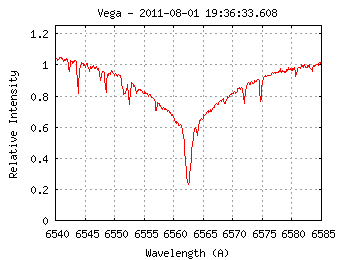
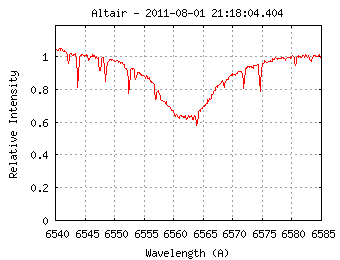

Gamma Cassiopae = reference Be star (air mass = 1.611)

P Cygni = Wolf-Rayet star = large and hot star that looses large quantities of matter and is surrounded by an optically thick stellar wind.
The H-alpha profile shows both an emission line coming from the star, and an absorption line coming from the colder stellar wind.
The absorption line is Doppler-shifted to the blue with respect to the main emission line, due to the expansion velocity of the wind.
(air mass = 1.183).

VV Cephei = eclipsing binary with long period of 20.3 year. VV Cep A is a red supergiant (type M2, one of the biggest stars known)
and VV Cep B is a main sequence, much smaller blue star (B8).
(air mass = 1.144)
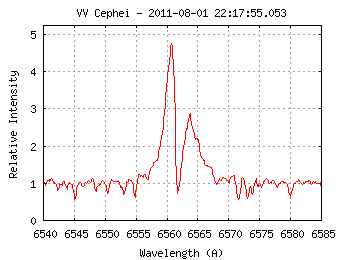
Epsilon Aurigae = eclipsing binary with long period of 27.1 year. The main star (type F) is eclipsed by an unidentified body.
The spectrum shows a lot of absorption lines, which I find surprising. Do they have a telluric origine ?
(air mass = 1.648)
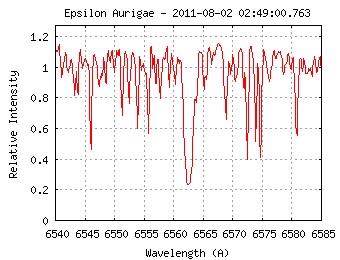
The idea was to observe the Doppler shift due to the star pulsations. The effect is described here.
(air mass = 1.036)
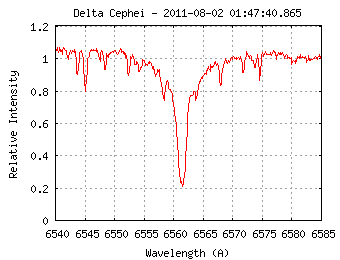
Gamma Pegasi = variable star from +2.78 to +2.89, with period 3.6h (type Beta Cep). Spectral type B2.
This star is special in that all lines in the spectrum are very sharp. There is no visible rotational line broadening,
and the turbulent velocities are very low
(ref = The atmospheres of the B stars - the spectrum of Gamma Pegasi, Astrophysical journal, vol 127, p125).
(air mass = 1.149)

During the night I did a couple of stupid pointing errors.
Gamma Lyrae was probably measured instead of Beta Lyrae, and Theta Aquilae instead of the cepheid Eta Aquilae.
(air mass of Beta Lyrae = 1.047, Eta Aquilae = 1.642)
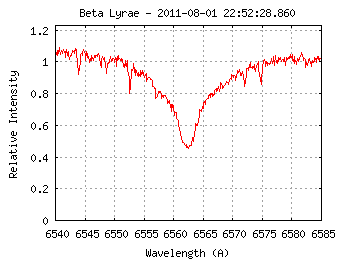
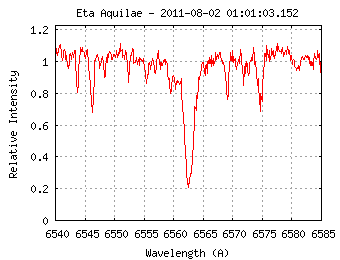
A spectrum of Jupiter, taken almost along the equator. The Jupiter lines are slanted due to the Doppler effect coming from the planet rotation. The telluric lines
are straight. The strong absorption line is the H-alpha line at 656.3nm.












